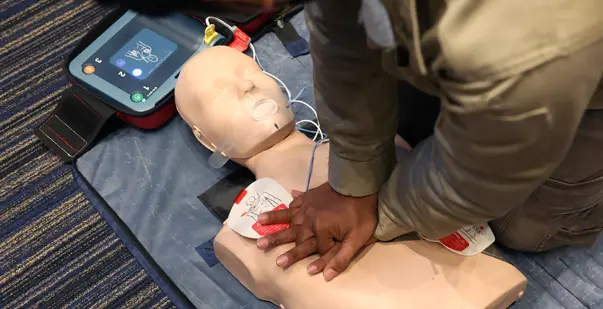Table of content(s)
- Introduction
- How does defibrillation work?
- What are the principles of early defibrillation?
- How to learn defibrillation?
- Conclusion
During a sudden cardiac arrest, it is crucial to count every second. Defibrillation is crucial at this hour and can save lives by restoring rhythms.
So what is the purpose of defibrillation? When a sudden cardiac arrest occurs, the heart’s electrical activity becomes chaotic. This causes it to stop pumping blood in an effective manner. A defibrillator is effective and delivers an electric shock to the heart. This helps reset its rhythm, allowing it to resume pumping in a normal manner. The key to successful defibrillation is offering this stock at the earliest.
There are multiple studies that prove that early defibrillation improves the chances of survival. Keep reading to explore the principles of early defibrillation and learn why it is so vital.
Master ACLS Now
Get ACLS certified with confidence
How does defibrillation work?
What is early defibrillation? It restores a normal heart rhythm during a sudden cardiac arrest. Here’s how it works:
- Purpose: It aims to stop the chaotic activity of the electrical pulses in the heart. It allows the heart to re-establish an effective rhythm.
- Electric shock: A defibrillator delivers shock to the heart using pads. These pads are placed on the chest. It stops the electrical activity of the heart for a certain span of time.
- Resetting rhythm: The brief interruption can reset the electrical impulses of the heart. By allowing the natural pacemaker to resume control, it effectively restores the heartbeat.
- Timing: Speed is important. Defibrillation must occur within a few minutes of sudden cardiac arrest. Survival chances can decrease significantly each minute.
- User-friendly design: Modern defibrillators are easy to use devices by non-medical individuals. They offer clear voice prompts and visual instructors. This guides users effectively through each step of the process.
- Follow-up care: Once defibrillation is given, ongoing medical care is crucial. This includes monitoring the condition of the patient and offering treatments.
Read more: Study Guide To Body Systems: ACLS Certification Resource
What are the principles of early defibrillation?
Each second that passes without treatment is harmful. This also causes the success rate to drop. This is why it is crucial to have accessible defibrillators in public spaces. This ensures that individuals are well trained to use themes effectively. Here are the most important principles of early defibrillation:
- Time is important: During a sudden cardiac arrest, every moment counts. Easy defibrillation ensures that a device can quickly send an electric shock to the heart and restore the rhythm. The faster you give the shock, the better the chance of recovery.
- Accessibility matters: Defibrillators are emergency equipment and should be easy to find. It should be made available in common spaces such as malls, airports, and schools. Anyone can use them with minimal training. This makes it possible to start treatment before professional help arrives.
- Training helps save lives: Before using a defibrillator, it is necessary to learn how to use one. Training programs teach individuals defibrillation dose and how to use them. They also teach ways to perform cardiopulmonary resuscitation.
- Public awareness: It is vital to make everyone aware of defibrillators. These are life saving devices that help save lives. Hence, it is a must to recognize cardiac arrest and understand the steps to take during such emergencies. Raising awareness encourages the use of such devices among more people.
- Community support: Communities can make a significant difference by keeping defibrillators handy. When they are kept in accessible areas, it ensures that anybody can use them during emergencies. This makes responses quick and boosts survival chances. It also ensures that they are well maintained.
- Medical coordination: When someone uses a defibrillator, it is important to coordinate well with medical services. Notify emergency services immediately to provide the highest level of care. This ensures that medical professionals can offer prompt treatment. It also offers constant medical aid to the person in need.
How to learn defibrillation?
Learning defibrillation involves understanding the use of an automated external defibrillator. This helps deliver an electric shock to individuals experiencing sudden cardiac arrest. Here’s how you can learn defibrillation:
- Take a course online: Several cardiopulmonary resuscitation courses teach the basics of an AED. Seek professional training by enrolling in courses that are nationally accepted.
- Online resources: There are several online resources that provide step-by-step guidance on using AEDs. These resources include simulations, videos, and modules to help you understand the process.
- Hands-on practice: You can also learn defibrillation from local community centers, workplaces, and schools offering the training. These allow you to learn and practice the device under the guidance of a qualified instructor.
- Read the manual: If you have an AED, you can learn its usage by reading the user manual. Automated external defibrillators are user-friendly, and the voice prompts guide you effectively.
Read more: Hemodynamically Unstable Patients: IV Fluid Therapy & Management
Conclusion
The purpose of defibrillation is to increase survival rates. While CPR helps in offering blood flow, early defibrillation regulates blood flow to the important organs of the body. It disrupts the chaotic rhythm of the body. This helps to continue normal and effective electrical activity by restoring the usual pacemakers. Hence, make sure you know the effective ways to use it and help save lives. Enroll online with a reputed course provider to learn more about defibrillators and their usage.







